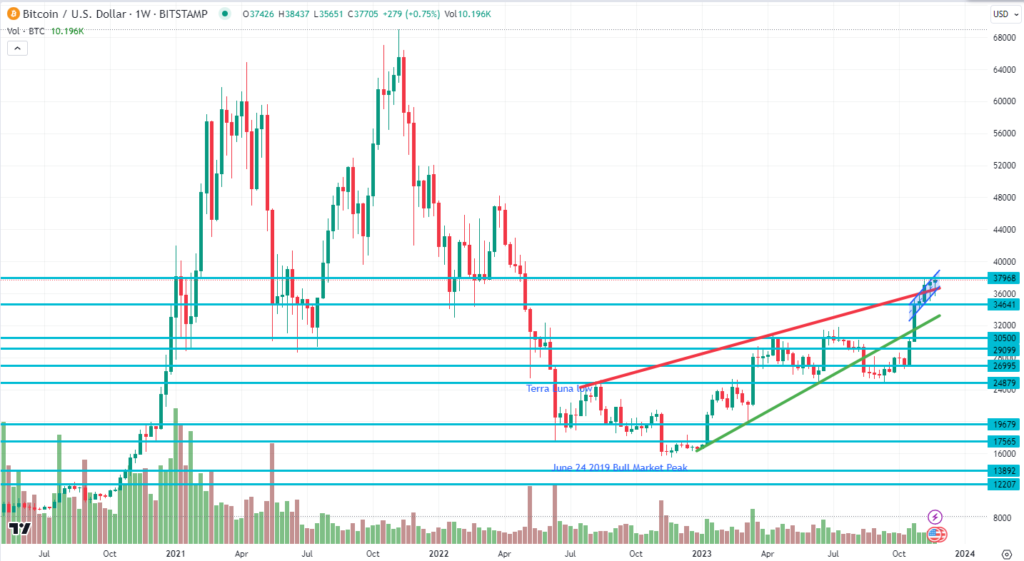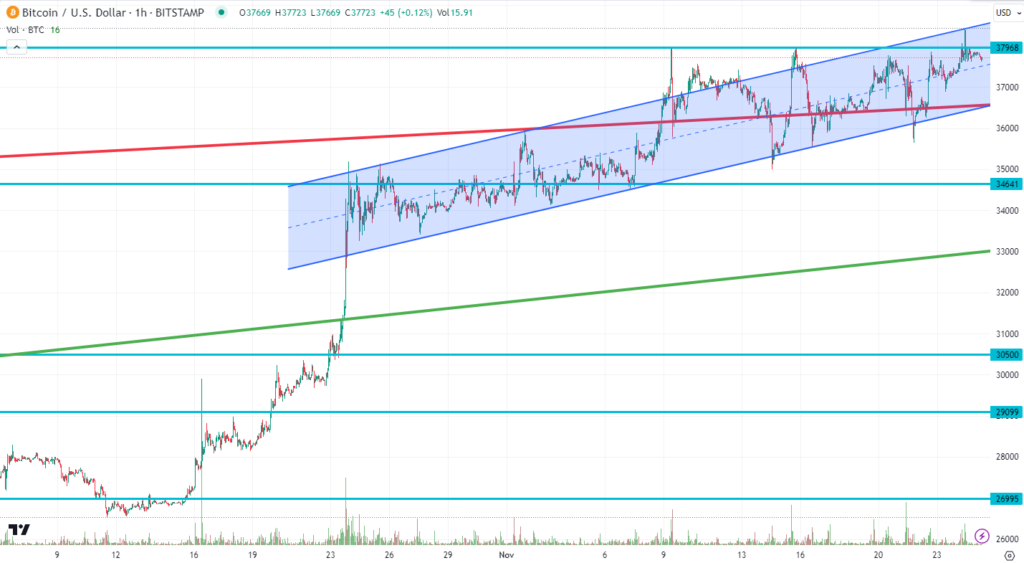I believe Bitcoin moves in cycles (that coincidentally or not are roughly aligned with the US presidential election cycle). The all-time high was in November 2021 at around $69,000 uSD.

By November 2022, Bitcoin was below USD 16,000, for a peak-to-trough drop of over 75%.
Since then, Bitcoin has been up 145% and will be the best-performing asset class in 2023.
That’s history, but who cares about history? We know Bitcoin, as a young asset class, is very volatile. The more important question is: what’s the future?
For the last month, Bitcoin has moved up in a parallel channel. Sometimes it breaks through the channel to the upside, sometimes to the downside, but it roughly follows that channel:

So, if you are a trader, over the last month, the correct strategy has been to place buy orders near the bottom of the channel and sell orders near the top, and you pocket a few bucks on the swings.
As long as that trend continues, it’s a simple strategy.
But uptrend channels don’t continue forever, so what is likely to happen next?
The big “macro” event we are all waiting for is the SEC approval of spot Bitcoin ETFs, which will likely happen in January (or February, or March). That news will likely cause a spike upward in Bitcoin, followed by the inevitable correction.
Bitcoin is up 145% this year. Everybody is front-running the news. When the news is released, nobody will be remaining to front-run it, and that’s when the correction happens.
Buy on rumour, sell on news.
We then have the halving, which is a pre-determined date when the supply of bitcoin that can be mined is cut in half. It happens every four years (just like the US presidential election cycle) and it will occur in May 2024. Based on the law of supply and demand, reduced supply should increase the price.
But again, everyone knows this, so speculators are front-running the halving.
So what is one to do?
I am of the view that, long-term, Bitcoin is a deflationary asset. Unlike fiat currency, the supply is limited, so long term, the price will increase. It makes intuitive sense to have a portion of your portfolio in Bitcoin. One percent, five percent, whatever your risk tolerance allows. We have ETFs in Canada; the spot ETFs in the USA will make this easier. That will drive investment.
But Bitcoin is very volatile. 75% drawdowns happen frequently.
So, the prudent course of action is to Dollar Cost Average. Buy a set amount every week, or month, or whatever, and over time your average cost basis should be lower than the market price.
Also, since crashes happen frequently, having cash available is a prudent strategy (not just for Bitcoin, but for everything). Bitcoin was under $4,000 during the pandemic crash. If you had cash, that was, in hindsight, a great buying opportunity.
I do not have a significant investment in Bitcoin. I’m old, and it’s too volatile. But, having a few dollars seems like a prudent asymmetric bet. If you have 1% of your portfolio in it, and it goes to zero, you lose 1%. But if it doubles, which it has already done this year, the rest of your portfolio can be flat and you are up 2% on the year. So, it’s worth monitoring.
Thanks for reading; see you next week.
A Deep Dive on Bitcoin
by JDH on November 25, 2023
I believe Bitcoin moves in cycles (that coincidentally or not are roughly aligned with the US presidential election cycle). The all-time high was in November 2021 at around $69,000 uSD.
By November 2022, Bitcoin was below USD 16,000, for a peak-to-trough drop of over 75%.
Since then, Bitcoin has been up 145% and will be the best-performing asset class in 2023.
That’s history, but who cares about history? We know Bitcoin, as a young asset class, is very volatile. The more important question is: what’s the future?
For the last month, Bitcoin has moved up in a parallel channel. Sometimes it breaks through the channel to the upside, sometimes to the downside, but it roughly follows that channel:
So, if you are a trader, over the last month, the correct strategy has been to place buy orders near the bottom of the channel and sell orders near the top, and you pocket a few bucks on the swings.
As long as that trend continues, it’s a simple strategy.
But uptrend channels don’t continue forever, so what is likely to happen next?
The big “macro” event we are all waiting for is the SEC approval of spot Bitcoin ETFs, which will likely happen in January (or February, or March). That news will likely cause a spike upward in Bitcoin, followed by the inevitable correction.
Bitcoin is up 145% this year. Everybody is front-running the news. When the news is released, nobody will be remaining to front-run it, and that’s when the correction happens.
Buy on rumour, sell on news.
We then have the halving, which is a pre-determined date when the supply of bitcoin that can be mined is cut in half. It happens every four years (just like the US presidential election cycle) and it will occur in May 2024. Based on the law of supply and demand, reduced supply should increase the price.
But again, everyone knows this, so speculators are front-running the halving.
So what is one to do?
I am of the view that, long-term, Bitcoin is a deflationary asset. Unlike fiat currency, the supply is limited, so long term, the price will increase. It makes intuitive sense to have a portion of your portfolio in Bitcoin. One percent, five percent, whatever your risk tolerance allows. We have ETFs in Canada; the spot ETFs in the USA will make this easier. That will drive investment.
But Bitcoin is very volatile. 75% drawdowns happen frequently.
So, the prudent course of action is to Dollar Cost Average. Buy a set amount every week, or month, or whatever, and over time your average cost basis should be lower than the market price.
Also, since crashes happen frequently, having cash available is a prudent strategy (not just for Bitcoin, but for everything). Bitcoin was under $4,000 during the pandemic crash. If you had cash, that was, in hindsight, a great buying opportunity.
I do not have a significant investment in Bitcoin. I’m old, and it’s too volatile. But, having a few dollars seems like a prudent asymmetric bet. If you have 1% of your portfolio in it, and it goes to zero, you lose 1%. But if it doubles, which it has already done this year, the rest of your portfolio can be flat and you are up 2% on the year. So, it’s worth monitoring.
Thanks for reading; see you next week.